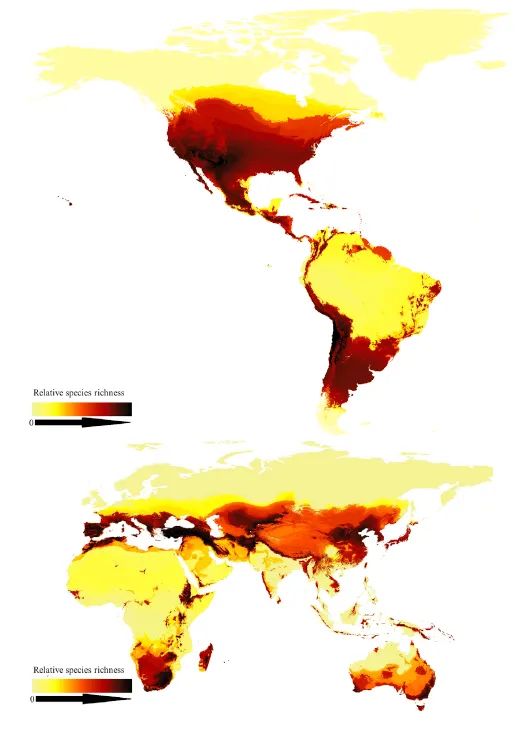Scientists Create a Buzz With the First Ever Global Map of Bee Species
Most of the insects avoid the tropics and choose treeless environments in arid parts of the world
:focal(3730x1727:3731x1728)/https://tf-cmsv2-smithsonianmag-media.s3.amazonaws.com/filer/c4/12/c412fb13-27ad-43cf-8b9c-d6060a24fe8b/dustin-humes-xd-dry9jjmc-unsplash.jpg)
From the collapse of honeybee colonies to the arrival of bee-eating “murder hornets” in the United States, bees have received swarms of attention recently, yet scientists know surprisingly little about where these animals live. Now a pioneering study, published today in Current Biology, reveals that bees avoid moist, tropical ecosystems and instead favor dry, treeless landscapes. The research shows the greatest diversity of species lives in two bands around the globe—mostly in temperate zones—an unusual distribution pattern.
Experts say this first-ever map of bee species around the world is a leap forward in understanding and protecting the pollinators that our food supply and ecosystems rely on. “Nobody has, to my knowledge tried to produce a map of bee diversity previously,” says Paul Williams, an entomologist at the Natural History Museum in London who was not involved in the work. “I think it's a fantastic move in the right direction.”
“Humans are pretty good at just going for what's easy, which is why we've got really great data on mammals, but then we overlook all the invertebrates, despite the fact they contribute some really important services within ecosystems,” says Alice Hughes, associate professor at the Chinese Academy of Sciences and author of the paper. “If we don't understand what those patterns of diversity look like, we've got no means of trying to conserve them.”
Mapping animals of any kind on a global scale is a challenge, but when assessing tiny, similar-looking species with patchy data, the task is particularly daunting. The team looked at nearly six million public records of where bees appeared around the world from five publicly-accessible open source databases. They then compared that information with a comprehensive checklist of species compiled by entomologist John Ascher available on DiscoverLife, an encyclopedia of global species diversity. The checklist includes verified observations, collected specimens and published records.
In the public open source records, a bee could be logged in the wrong location because someone misplaced a minus sign when documenting the species, for example, says Hughes. If a species name was misspelled, the team wanted to make sure it wasn’t logged as a new species. The researchers eliminated misidentifications, inaccurate location points and other errors by checking the public entries against that DiscoverLife checklist.
One of the issues with open-source data repositories is that they are riddled with errors and biases that can be misleading, says Daniel Cariveau, a professor in the department of entomology at the University of Minnesota and leader of the Cariveau Native Bee Lab who was not involved in the research. “Bees aren't like birds — they're really hard to identify. You need really good taxonomists to do this,” says Cariveau. “And this paper, these authors, are really some of the best taxonomists in the world.”
Hughes and colleagues also set standards for the quantity of the data used in each region to make sure the results weren’t weighted unfairly toward places with more records. She says the end result was a map that was as accurate as possible.

The research revealed that bee species were most numerous in two bands around the globe, with more species in the Northern Hemisphere—in areas including California, Morocco and the Himalayas—than in the Southern Hemisphere—in regions including South Africa and the Andes. While most plant and animal species are richest in tropical areas, bees avoid these ecosystems along with the colder areas near the poles.
This two-banded distribution is an anomaly, says Cariveau. “If you were to study beetles, or butterflies, or moths, or things like birds, you see this unimodal pattern where you get this increase in the tropics. So this is a really unique thing." Though rare, some marine species and mammals can also follow this distribution.
Williams says this work brings into focus what many bee researchers suspected from smaller-scale efforts to map the diversity of bees on local levels. Williams thinks the bees’ avoidance of tropical and forested environments likely has to do with food abundance and nesting choice. Most bees aren’t social honey-producers. They often live alone and don’t sting. And because many of these solitary species nest in the ground, the water-logged earth of tropical environments means fungi could spoil their food stores, threatening the bee’s survival.
Moisture isn’t the only reason bees seem to dislike tropical ecosystems. Drier deserts environments have super blooms that can support a huge number of bees at once. “In the deserts and on the desert edges, you often get great flushes of flowers after there's been rain,” says Williams.
Bees can exploit these resources quickly and feed off their pollen stores in hotter and drier seasons. But their environment can’t be too dry. Bee species were at their most abundant near deserts that have surrounding vegetation and are ripe for plant growth.
One barrier to creating comprehensive species maps is a lack of open, accessible data on bees. Countries are not incentivized to share their records, says Hughes, which bars other researchers from benefiting from their work. Both Hughes and Williams say that sharing data internationally would be a boon to their work and could produce even more accurate results. Williams says he’s curious to see how species patterns look when broken down into sub-groups, like ground-nesting bees, stingless bees or honeybees.
With the impacts of climate change mounting, Cariveau says this work could point to bee habitat that needs protection now, and to areas bees might live in the future. “Whether the plant communities can migrate given climate change, whether bees can follow those I think, is a pretty interesting and important thing to be figuring out as we move forward,” says Cariveau.
/https://tf-cmsv2-smithsonianmag-media.s3.amazonaws.com/accounts/headshot/corryn.png)
/https://tf-cmsv2-smithsonianmag-media.s3.amazonaws.com/accounts/headshot/corryn.png)